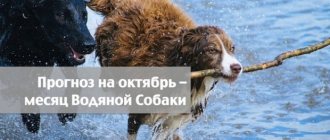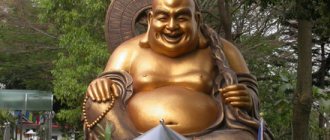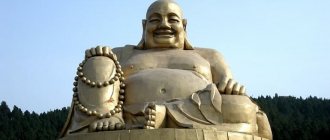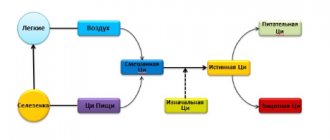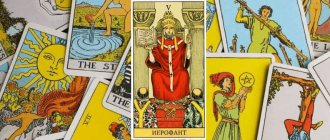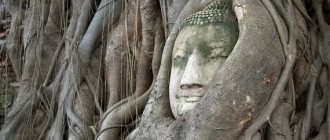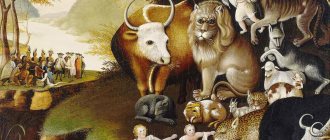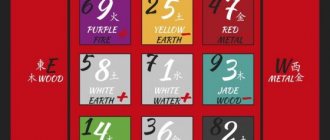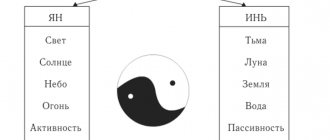Purpose and form
Fu dogs, as a talisman, perform the functions of protecting the home from negative and hostile emotions, and also protect a favorable atmosphere in the home. Fu dogs always act in pairs. A male dog represents the masculine yang energy, and a female dog represents the feminine yin energy. They can protect the home and its inhabitants, being both inside the house and outside, at the main entrance. If they are called upon to protect a work office, they can reflect negative influences on the conduct of business. For example, preventing bankruptcy.
Fu Dog
Externally, Fu dogs are very similar to lions. No wonder they are also called Buddha's lions. The fact that these are still dogs is evidenced by protruding ears.
Both dogs are always depicted standing on three legs. The male's right front paw covers the ball. It is believed that this is not just a ball, but an allegory of the entire globe. This symbolizes fatherly control over external circumstances and the ability to prevent everything bad. The female mother covers her baby with her left paw, showing her desire to protect the inhabitants of the house and create favorable conditions in it.
The size and material from which Foo dogs are made matter. If they are installed on the street for external security of the house, then it is better to make them large from concrete, stone or metal. Let the appearance be formidable or even intimidating. Let the dogs indoors be small in size and more good-natured in appearance. It is better to make them from pleasant materials - glass, porcelain or ceramics.
Buddha Lions
Foo Dogs
It is interesting that for China the lion is an unusual animal, because they were not found there before, but were brought as gifts to the emperors. Perhaps their strength, beauty, power was the reason that they were made sacred animals in Buddhism. There is also an opinion that, after this teaching came from India to China, the Buddha himself was called Fo, and his guards were called Heavenly Lions or Fo Dogs. Subsequently, over time, Fo became Fu, and the lions “transformed” and began to be called Fu dogs (after all, a lion for China, as already mentioned, is atypical, but with dogs the situation is much better). However, if you look closely, the dog Fu has a lot in common with the king of beasts. In fact, in some cases only protruding ears can serve as a distinctive feature, but otherwise Fu dogs are typical lions.
History of origin
Expert opinion
Melnik Dmitry
feng shui master
Fu dogs as a talisman of protection appeared in Ancient China in the 3rd century BC. e. Along with the religion of Buddhism came protective talismans in the form of lions. But the king of beasts is an uncharacteristic animal for China. Gradually his image transformed into a more familiar dog. But in fact, this is a kind of hybrid: from a lion, the animal has a curly mane, and from a dog, it has erect ears.
The Chinese dog Fu initially guarded only the emperor, his palace and family. There were six pairs of these animals in the imperial palace. It was forbidden for anyone else to have their images and use them as protectors. Gradually, this ban weakened, and Fu dogs appeared in the houses of the emperor's associates and noble dignitaries. They not only protected the peace of the nobles, but also demonstrated that the owners belonged to the elite class.
Today anyone can purchase these protectors. But they still symbolize a hint of the elevated status of their owners.
Fu Dogs - Buddha's Celestial Lions
Fu Dogs, Buddha's Heavenly Lions, Lion Dogs and Their Roles in Feng Shui
Good afternoon
Pendants appeared in my store - amulets made of ocular quartz (tiger and hawk's eye, bull's eye). What are they and what do they symbolize?
Those who have ever been to China, Thailand or other Southeast Asian countries have probably noticed that at the entrance to any more or less decent building there are always sculptural images of guards. Usually they look like lions. But not always. Sometimes they look like dogs, or sometimes they’re a cross between a dragon and who knows what. Here, for example, are such miracle animals:
What kind of animals are these, why are they sitting? For all other nations, the lion is the king of beasts, but it was never an indigenous inhabitant of China, and only the Emperor had several strange beasts in cages. In early Chinese art, lions were not depicted at all, but with the development of imperial power and, especially, Buddhism, they became the personification of guardians of the law and protector of sacred buildings. What is the most sacred building? Of course, the home of the most important among the Chinese - the Emperor! Initially, the Heavenly Lions began to serve as protectors only of the imperial palace. And many years later they began to place them in front of palaces, temples and government institutions. And only then they began to be placed simply in front of rich houses, and they turned into a symbol of high social status and, not unimportantly, the material well-being of the family.
Traditional Chinese lion sculptures are called Buddha's Heavenly Lions (Guardian Lion, 狮, shī, shi). But according to Feng Shui, they also have a second name: Fu Dog, Foo Dog. There is an opinion that when Buddhism came from India to China, Buddha was called Fo, and his guard lions were called Buddha's Heavenly Lions or Fo Dogs, but then Fo was replaced by Fu, the lions were replaced by dog lions, and so the abbreviated name Fu Dogs appeared.
It is believed that the name Fu Dog comes from the name of a group of dogs that include the Pekingese, Pug, Chow Chow and some others, but this is a controversial issue. Most likely, the opposite happened - a group of dogs began to be called Fu Dogs after the ancient Fu Dogs - guards and protectors.
Mention of Fu Dogs dates back to the Han Dynasty, in 208 BC. – 221 AD There is an ancient legend that these animals contain milk in their paws, and they also love to play with balls. Therefore, in those days, people left balls in the forest in the hope that the Fu Dogs would come and start playing with the balls and leave at least a little lucky milk on them. For centuries, people have tried to collect lion's milk from these balls and use it in traditional Chinese medicine.
Heavenly lions always look scary. Bulging eyes, creepy fangs, large claws, a developing mane. However, there is nothing terrible about them. On the contrary, they are very cute and fluffy. They drive away evil spirits and are a concrete symbol of protection. This is how cute he is:
Now Fu Dogs are used to scare away evil forces and spirits not only in front of and inside houses, but also in front of garden gazebos and wherever evil forces may appear. They are used to protect against theft, by placing them inside the house with their faces towards the door during departure, from bankruptcy, by placing them in the office and in many other places to prevent any negative energy from entering the house or office.
And it is not at all necessary to sculpt huge sculptures of dog dogs from marble or concrete in front of the entrance to your home or office. It is enough to have with you (or on yourself) a figurine of this glorious animal. Or better yet, according to Feng Shui, two figures, the personification of yin and yang.
For example, I have gorgeous eye quartz amulets in my store that can be hung as a pendant, made into a bracelet and used, or placed in your home or office as a talisman.
The figurines are made of natural eye-shaped quartz. This stone, being in itself one of the most powerful amulets, significantly enhances the protective properties of the talisman. These figures can also be used as original amulets pendants. That's what the Chinese do. For example like this:
As I already mentioned, they are used inside the house to protect against robbery, in the office - against bankruptcy, and on oneself - against the evil eye. In general, indoors they should be placed so that they look towards the street (either at the front door or out the window). It is believed that this is how dogs repel external negativity, which could somehow harm your home.
In a word, Fu Dogs are a universal talisman of good luck and protection that can be used anywhere , depending on what you want. You can install it in a car, and it will protect its owner on the road, giving him good luck and safety. In conclusion, we can say that Foo Dogs are a powerful talisman. And if you want protection from various misfortunes, and good luck in life, then buy yourself one. After all, it was not for nothing that eastern emperors installed them in front of their palaces.
Here, admire the Imperial Lions in the Forbidden City in Beijing:
Where and how to place it?
- If Fu figures are installed outside the house, then they should be located at the entrance, on both sides of it. They can face outwards, reflecting negative energy from the house, or be directed towards each other, guarding the entrance and controlling visitors. Anyone entering the house should see a female on his left and a male on his right.
- If the entrance is located on the south side of the building, then according to Feng Shui it is recommended to install dog figures made of metal there.
- Animals inside the house look at the entrance to the outside world - a door or window. If the owners leave their home for a long time, it is useful to install dog figures near the door so that they reliably protect the entrance to it.
- It is better not to allow threatening-looking dogs inside the house; let them be vigilant outside. There should be outwardly good-natured defenders in the house. The main thing is that the owners should like the figures. And for unwanted visitors they will still be formidable opponents.
- Dogs placed in the family area will protect and maintain peace and order in it. In the wealth zone, they protect the wealth of the owners of the house.
What does this talisman mean?
The Fu dog symbolizes good luck, prosperity, and happiness. The figurine protects against negative energy; it is placed at home, on the street, in the car, in the workplace. It is recommended to use a pair - a male and a female, which personifies the feminine and masculine principles.
We have selected interesting articles for you:
Feng Shui meaning of the variety of 7 elephant figurines
07.12.2021
The most powerful runes to attract unconditional love
20.03.2019
The male holds his paw on the ball. In ancient China it was a simple ball, today it is associated with the planet Earth. The talisman represents the supreme guardian, the father, who controls external circumstances, protecting the earth from evil forces. The figure is responsible for luck in business and power.
The female acts as the standard of femininity; she is depicted with a cub. The figurine is responsible for protecting the home, family, children and childbirth, home comfort and hearth.
In tandem, Fu dogs complement each other, protect the external and internal world, and act as one. If one of the figurines suddenly gets damaged, then both figurines need to be replaced.
Where to place the figurine in the house
The Fu dog is placed both indoors and outside the house, for example, near the entrance doors, gates, and in the yard. This will help protect against negative influences, bad energy; people with bad thoughts will not be able to enter the house.
By installing a talisman in the middle of the room, you will attract good luck and protect the house from robbery, evil intentions, and damage. To do this, the figure’s muzzle should be directed towards the exit. The placement of dogs in certain areas determines the protection of positive energies in your life. By placing them in the wealth zone, you will attract wealth and well-being; in the work zone, you will attract energy, incentive, and protection from bankruptcy.
During installation, follow a number of rules:
- figurines should always stand in pairs;
- the male is positioned to the right of the front door (when viewed from the outside), as he presses the ball with his left paw;
- the female is placed on the left, as she presses the puppy with her left paw;
- for outdoor installation, metal (if the entrance is located on the south side), concrete figurines are chosen, for indoor use - from glass, porcelain;
- from the outside, the talismans should face each other, from the inside towards the exit;
- if there is a large tree in the yard, then the figurine is placed on the windowsill.
Dogs have a positive effect on people of the water element, those born in the year of the Boar and Rat. At the same time, it is forbidden to place figurines in the recreation area (bedroom, children's room), because the energy, the power of the talismans will disturb your peace.
What can't you do with Fu dogs?
Fu dogs are an inseparable couple. One dog is unable to provide protection, only two of them can. If one of the figures is lost or damaged, you must purchase a new pair. Trying to replace the old dog with another will not lead to anything good.
You should not place Fu dogs in bedrooms or places intended for relaxation. Two strong energies in the same zone will interfere with each other.
Fu dogs can be confused with similar talismans, such as the mythical creature Pi Yao. One thing to remember is that they can never have wings, horns or scales.
It is believed that a couple of Fu will protect their owners no worse than living dogs. Such a protective talisman is also an unusual home decoration.
How to activate the dog mascot
After bringing the protective talisman into your home, clean it with water and salt. To activate the Fu dogs, place the figures in the center of the table and place 12 candles around them. While the candles are burning, an invisible ball will cover the house like a protective cylinder.
According to Feng Shui, the dog is activated by words such as: “I am under the protection of the Universe, my finances are safe and sound, I always make profitable purchases, my expenses always pay off.”
After this, you need to place the talisman in one of the zones.
